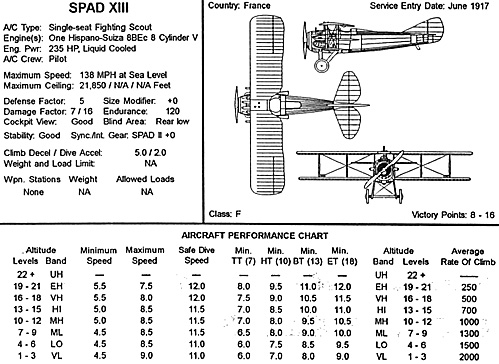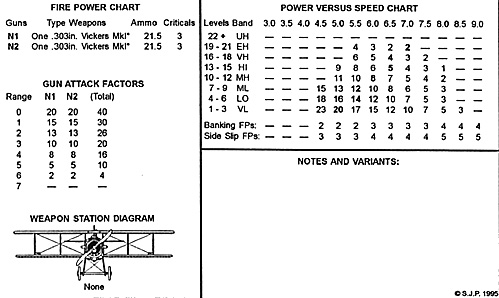"It was a fine August morning to hunt the Hun. The other three members of my flight, while not as famous as Captain Rickenbacker or other fellow members of the 94th, were all quite competent fellows in their own right. We all felt confident that in this early morning patrol that we would certainly take a few scalps. We made sure that we had procured good aircraft as well-none of those war-weary airframes that the new pilots to our outfit fly!"
Canvas Falcons, the first release in our "Fluttering Wings" series of games will write the final chapter on the air combat system developed by J. D. Webster. Canvas Falcons introduces players to the tactics of WWI aviation. The scale of the game is 4.5 seconds per turn, 100 feet per hex, 50 foot altitude increments, 3,000 foot altitude bands and each Flight Point is 15 miles per hour.
"Our mission was to take off, cross over the trenches, and to overfly two enemy aerodromes to see if we could stir up some action with the Hun, and then to return. Fuel wasn't much of a concern. Our SPAD XIIIs had a two hour endurance so the worry of being short of fuel behind enemy lines wasn't a serious concern to us."
While the aircraft data card shown is only a working layout, players familiar with OTR and ASP will have no problem following it. However, the power vs. speed chart may be somewhat misleading. The SPAD XIII shows 20 accel points while at a speed of 5.0 (75 MPH). This actually represents an acceleration of only 30 MPH during that turn. The accel points are based on coefficients of lift and drag, thrust required and available horsepower, and were determined for every 7.5 MPH. One result of this is the power vs. speed chart shows the flight envelope. Thrust available falls off sharply as altitude and air speed increases. Flying above 15,000 feet introduces the aircrew to the effects of hypoxia, which gives an active crewmember about 10 minutes of useful consciousness.
"In any event, we took off and began our journey to find the Hun, slowly climbing towards the enemy trenches. We had climbed up to about six thousand feet when I noticed Kreiser, my assistant flight leader, motioning to me. He wanted to get up higher before we crossed the trenches to avoid the ack-ack as well as to get a good height advantage in case of a scrap with the Huns. I nodded to him, and began the climb, when, suddenly just off to the left of the sun in our faces, I spotted four Hun Fokker DVIIs swooping down upon us in a beautiful stacked echelon. Curses! What were the Huns doing on THIS side of the trenches? They usually didn't come over here -- they usually preferred to let us come to them! Anyhow, this was deadly business! I racked my wings and turned to meet the diving Huns. The other three flight members sluggishly responded. Perhaps they were more surprised than I by this Hunnish deviousness!
The ability to perform flight maneuvers is dependent on maximum turn rate. For example, the SPAD XIII could enter a vertical climb only when able to pull BT type turns, which in the VL band is at a speed of 8.0 (120 MPH). The turn decel was also determined using coefficient of lift, drag, angle of bank and load factor. While many of the game's concepts will be similar to those familiar with the Air Power and Fighting Wings systems, we're working hard to come up with new and innovative ideas to bring the flavor of WWI aerial combat to the fore in this system. The one aspect that seems to really set the WWI aircraft apart is their ability to turn very tightly, and their inability to maneuver in the vertical plane as well as their future counterparts.
To be able to loop, one must have the aircraft flying flat out before the pull-up to avoid a stall and spin on the top. The flight envelope or the difference between maximum and stall speeds, is considerably smaller in these aircraft than those of later eras. For example, An F15 at low altitude can fly at speeds ranging from around 150 to 900 mph, a 6-to-1 flight envelope. The P-51D could fly at low altitude from speeds ranging from about 100 to 400 mph, a 4-to-1 flight envelope. The SPAD XIII, a rather 'hot' performer for its day, flew between about 70 to 140 mph, a 2-to-1 envelope.
Maneuvering in this strict envelope demands a very strict discipline. There's no room for fudging or for error. Another difference is the relative acceleration curve. The WWI types typically accelerate quite sprightly near their stall speeds, but have very little excess power at their top speed as compared to their later counterparts. Just flying the aircraft without fighting them shows the player of the game valuable historical lessons about these early aircraft and what they were like to fly.
"Down the Fokkers came. We pulled our noses up to meet them head on. But that wasn't what they had in mind! They pulled hard into a steep diving left turn and began to work their way behind us! We pulled hard on our sticks and rudders, getting our SPADs to turn as tight as they could. But, they couldn't turn like the Fokkers. I watched with amazement as they turned much tighter than we could and got right behind us, just out of their firing range. If we didn't think fast, they would open up with their twin Spandaus and tear into canvas, engines, fuel tanks and bodies.
Kreiser and his wingman decided that it was time for a hasty escape. While the Fokkers could out-turn us, nothing could out-dive our heavy, powerful SPADs. Down they went, out of the scrap. The Huns realized they couldn't keep up with that, and continued after me. The odds were four against two, but I was still ,full of fight! This feeling, however, left me quickly, when one of the Fokkers got in a quick burst at long range, putting a couple of holes in the fuselage! Fortunately, they didn't hit anything important! There I was, with my wingman, outnumbered and in a bad situation. I then realized that maybe there was another way out.
The Huns behind me had anticipated that we would try to dive out of this as well, and had some aircraft lower than us to cover that likelihood. Even though those Fokkers likely had the more powerful engine that we'd heard rumors of, I guessed that our SPADs could still fly faster straight and level and in the climb. If I was wrong, it would mean likely death for the both of us. I slammed the throttle forward and put the nose up. Gradually, we began to open the distance and the Huns fell away and behind. Once they realized they couldn't keep up with us, they broke off the action".
Previous WWI air games typically simplified air to air armament, with all aircraft usually having one or two machine guns. These resolve fire on a simple CRT, while aircraft armed with Lewis guns fall somewhere in between for effect. In Canvas Falcons, the fire power charts reflect more than just attack factors. Each weapon in the inventory was evaluated on its muzzle velocity, rate of fire, bullet weight and burst length. A wide variety of weapon improvements were tried throughout the war, from muzzle boosters to Foster mounts.
Canvas Falcons faithfully replicates the advantages and disadvantages of these ideas. Machine guns firing through the propeller are very dependent on the rate of fire allowed by the synchronizer or interrupter gear. For example, the Ross interrupter gear allows a rate of fire of 300 rounds per minute, while the SopwithKauper system gives a rate of fire of 650 RPM, giving the aircraft with the Sopwith-Kauper gear a distinct advantage. While the synchronizer/ interrupter system produced better gunnery results, it could also place the firing aircraft at risk. A mis-fire or glitch in the system could cause the machine gun to shoot off its own propeller, or worse, the engine could be ripped off its mounts by the unbalanced propeller. The results would be a forced landing or worse.
"We re-formed our flight with a sigh of relief. We then crossed over the trenches and continued our patrol. Perhaps the Hun was sleeping in that day or they were just afraid to come up after us, because we didn't get anymore action. We then returned for an uneventful landing back at the home aerodrome. Perhaps it was just as well that we didn't get into any action, since the chief mechanic found a broken part in the interrupter gear of my wingman's plane. That would have been possibly disastrous. In any event, there would be other patrols and fights against the Hun. And we would be ready...
In closing, there are many ideas still being brainstormed, tested, and being worked on to truly set Canvas Falcons apart from the other air combat games in the Clash of Arms family and reflective of its era. For those of you still waiting for a new, truly up-todate quality WWI air combat simulation that will really show you what it was like. Rather than being more of a fun game that doesn't bear much association with reality, Canvas Falcons providing players with all the feel and challenges of developing future tactics in their own "canvas falcons"!


Back to Art of War Issue # 22 Table of Contents
Back to Art of War List of Issues
Back to MagWeb Master Magazine List
© Copyright 1995 by Clash of Arms Games.
This article appears in MagWeb (Magazine Web) on the Internet World Wide Web.
Other military history articles and gaming articles are available at http://www.magweb.com